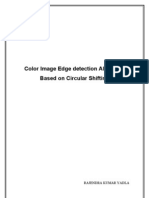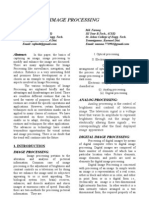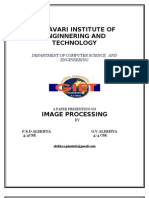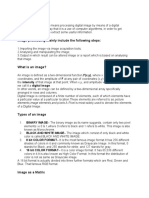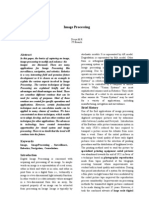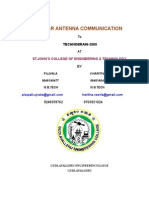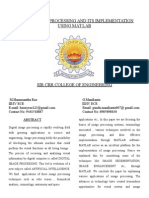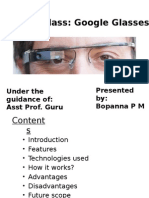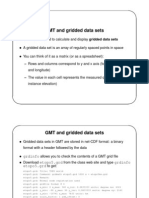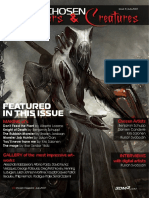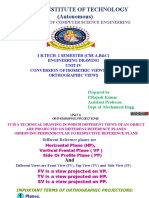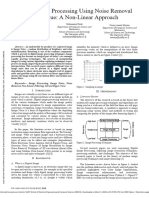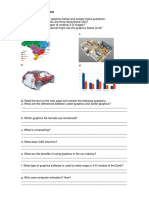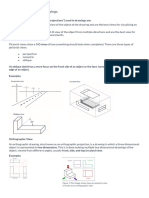DIGITAL IMAGE PROCESSING
KAKINADA INSTITUTE OF
ENGINEERING & TECHNOLOGY FOR
WOMEN
PRESENTED BY
J.AMRUTHA(smiley.amrutha45@gmail.com
)
KSV.SRI
DIVYA(kankipatidivya@gmail.com)
�V.MAHESWARI(vundavalli.mahi@gmail.co
m)
�DIGITAL-IMAGE
PROCESSING
ABSTRACT:
By using Digital Image Processing
we enhance the digital images and
extracting information and features
from
the
image.
Digital
Image
Processing has become the most
common form of image processing.
This is one type of image processing
and it used for editing the digital
FEATURES: The other features
of
this
technology
Alteration,
Removal
Cropping
of
elements,
is
on
noise
merging
Image
and
of
Size
Image,
unwanted
images and
finally color adjustments.
INTRODUCTION:
images which are taken from the
digital cameras.
IMAGE PROCESSING:
TECHNOLOGY:
Image
This technology is more useful in the
features
investigation in Crime Branch. Digital
manipulation and alteration of images
Image Processing has the advantages
by using computer software.
applied to the input data and can
avoid the problems such as build-up of
and
signal
is
enhancing
image or extracting information or
as a wider range of algorithm to be
noise
processing
distortion
during
processing. They accept images in
large variety of image formats.
from
an
image.
The
DIGITAL IMAGE PROCESSING:
Digital image processing is the use
of computer to perform on. Digital image
processing has the same advantage it allows
�a much wider range of algorithms to be
problems such as the build-up of noise and
applied to the input data, and can avoid
signal distortion during processing.
PURPOSE:
learning.
To identify criminal acts:
Few types of evidence are more
incriminating than a photograph or
videotape that places a suspect at a crime
scene, whether or not it actually depicts the
suspect committing a criminal act.
TYPES OF IMAGE PROCESSING:
1. Binary Image: A binary image is a
digital image that has only two
possible values for each pixel.
2. Gray Scale: Grayscale images have many
shades of gray in between. The contexts
other than digital imaging, the term "black
and white" is used in place of "grayscale"
3. Color Image: A (digital) color image is a
digital image that includes color information
APPLICATIONS:
Image processing by planetary
scientists to enhance the images of
Color Change: Image editors have the
ability to selectively change the color of
specific items of an image.
planets.
Doctors use this technique to
manipulate CAT scans and MRI
for each pixel.
images.
Image processing in laboratories
An example of selective color change, the
original is on the right
can motivate students and make
science relevant to student
HOW CAN WE PROCESS AN IMAGE:
The first step in digital image processing is
to transfer an image to a computer,
�digitizing the image and turning it into a
CATEGORIES
computer image file that can be stored in a
IMAGE PROCESSING:
OF
DIGITAL
computer's memory or on a storage medium
such
as
hard
disk
or
CD-ROM.
Digitization involves translating the image
The Three main categories of digital image
processing are:
into a numerical code that can be understood
by a computer. It can be accomplished using
a scanner or a video camera linked to a
frame grabber board in the computer. The
computer breaks down the image in to
thousands of pixels. Pixels are the smallest
component of an image. They are the small
dots in the horizontal lines across a
Image
Compression
is a mathematical
technique used to reduce the amount of
computer memory needed to store a
digital image.
The computer discards
(rejects) some information, while retaining
sufficient information to make the image
pleasing
to
the
human
eye.
television screen. Each pixel is converted
into a number that represents the brightness
of the dot. For a black-and-white image, the
pixel represents different shades between
total black and full white. The computer can
then adjust the pixels to enhance image
Enhancement Image enhancement techniques
can be used to modify the brightness and
contrast of an image, to remove blurriness,
and to filter out some of the noise. Using
mathematical equations called algorithms,
quality.
the computer applies each change to either
�the whole image or targets a particular
The same picture in two different color
portion of the image.
modes.
For example, global contrast enhancement
would affect the entire image, whereas local
contrast enhancement would improve the
contrast of small details, such as a face or a
license plate on a vehicle. Some algorithms
can remove background noise without
The picture on the left is the original
disturbing the key components of the image.
photograph, in full color. The picture in the
center is in grayscale. The picture on the
Measurement Extraction is used to gather
right is in black and white, or monochrome.
useful information from an enhanced image.
IMAGE VEWING:
4. False Color: For military operations
under a false flag, see
The user can utilize different program to see
the image. The GIF, JPEG and PNG images
can be seen simply using a web browser
because they are the standard internet image
formats. The SVG format is more and more
used in the web and is a standard W3C
format.
This "true color" image shows the
IMAGE TYPES :
Digital images can be classified according to
same region as the "false color" image
above, but uses true colors, e.g., the
plants are shown in green. A false-
the number and nature of those samples. The
color image is an image that depicts a
term digital image is also applied to data
subject
in
associated to points scattered over a three-
human
perception
dimensional region, such as produced by
subject. Also known as a pseudo-
topographic equipment. In that case, each
color image, it is derived from a
datum is called a vowel.
grayscale image by mapping each
colors
that
of
differ
from
the
same
pixel value to a color according to a
�table or function.. Although false-
small
band
of
visible
spectra.
coloring does not increase the
information
contents
of
the
original image, it can make some
details more visible, by increasing the
distance
in
color
space
between
successive gray levels.
For example, a photographic negative could
be called a false-color image, since it shows
the complementary colors of its subject.
However, the term "false-color" is typically
used to describe images whose colors
represent measured intensities outside the
visible portion
of the
electromagnetic
spectrum .False-color images are frequently
used for viewing satellite images, such as
6. Thematic Image : Thematic images
are usually image products of classification
processing of multispectral images of the
from weather satellites.
earth surface. The classification process
5. Multi Spectral Image: Multi-spectral
differentiates types of surface such as land,
images are images of the same object, taken
water, forest, lake, structure etc
in different bands of visible or infrared
region of electromagnetic continuum. This is
the main type of images acquired by Remote
sensing (RS) radiometers. Multi-spectral is
the opposite of panchromatic.
Usually
satellites have 3 to 7 or more radiometers.
DIGITAL IMAGE EDITING:
Digital image editing is the process of
altering digital images, whether they be
digital photographs or other types of
digitally represented images.
Each one acquires one digital image in a
Specialized software programs called vector
graphics editors or bitmap graphics editors
are the primary tools with which a user may
�manipulate, enhance, and transform images.
BASICS
These editors are capable of editing images
EDITING:
in many diverse ways
.
OF
DIGITAL
IMAGE
Bitmap images are stored in a computer in
the form of a grid of picture elements called
pixels. These pixels contain the image's
color and brightness information.
Image
editors can change the pixels to enhance the
image in many ways. The pixels can be
changed as a group, or individually, by the
sophisticated algorithms within the image
editors.
EDITING IMAGE AS HORROR
�IMAGE EDITING PROGRAMS:
Because of the popularity of digital cameras,
image
editing
programs
are
readily
available. Minimal programs, that do such
operations as rotating and cropping (image)s
are often provided within the digital camera
itself, others are returned to the user on a
compact disc (CD) when images are
processed at a discount store.
IMAGE EDITOR FEATURES:
Listed below are some of the most used
capabilities
DIGITAL DATA COMPRESSION:
Many image file formats use data
of
the
better
graphic
manipulation programs.
compression to reduce file size and save
The list is by no means all inclusive. There
storage space.
are a myriad of choices associated with the
Digital compression of
images may take place in the camera, or can
application of most of these features.
be done in the computer with the image
editor. When images are stored in JPEG
format, compression has already taken
place. Both cameras and computer programs
allow
the user to
set the
level
of
compression. Some compression algorithms
Image
Size
Alteration:
Image
editors can resize an image, making
it larger,
or
resolution
smaller.
cameras
High
can
image
produce
large images which are often reduced
in size for Internet use.
are lossless, such as PNG, which means no
Image
image quality is lost when the file is saved.
mathematical
The JPEG compression algorithm uses a loss
sampling to calculate new pixel values
format. The greater the compression, the
whose spacing is larger or smaller
lesser the quality. The JPEG algorithm
than the original pixel values.
utilizes the way the brain and eyes perceive
color to make loss of detail less noticeable
.
editor
Cropping
programs
process
An
use
called
Image:
a
re-
Digital
editors are used to crop images.
Cropping creates a new image by
removing
desired
rectangular
�portion
from
the
image
being
Removal
of
Unwanted
Elements: Most image editors
cropped.
can
be
used
to
remove
unwanted branches, etc, using
The unwanted part of the image is
discarded. Image cropping does not
reduce the resolution of the area
cropped.
Noise Removal: Image editors
may
feature
number
of
algorithms which can add or
remove noise in an image. JPEG
artifacts can be removed; dust
& scratches can be removed
and
an
image
can
be
despeckled.
Noise tends to invade images
when pictures are taken in low
light settings.
a "clone" tool.
��ADVANTAGES:
One of the biggest advantages of digital imaging is the
ability of the operator to manipulate the pixel shades
to correct image density and contrast, is called
Post-Processing.
DISADVANTAGES:
There are also disadvantages associated with the use of digital systems.
The initial cost can be high depending on the system used, the number of detectors
purchased, etc.
Competency using the software can take time to master depending on the level of
computer literacy of team members. Finally, since digital imaging in dentistry is
not standardized, professionals are unable to exchange information without going
through an intermediary process.
CONCLUSION:
Image editors provide the means for altering and improving
images in an almost endless number of ways. They accept
images in a large variety of image formats, and after changes
are made they allow the changed image to be saved in any
number of image formats, at almost any size, and in varying
degrees of compression. Most serious digital camera users will
find the facilities of an image editor indispensable.

